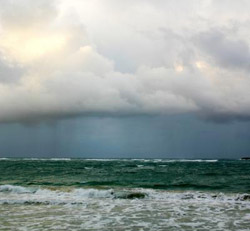Climate change and the South Asian summer monsoon

This shows the approaching monsoon rain.<br>Credit: Gisela E. Speidel, International Pacific Research Center<br>
A review in Nature Climate Change (June 24 online issue) of over 100 recent research articles concludes that with continuing rise in CO2 and global warming, the region can expect generally more rainfall, due to the expected increase in atmospheric moisture, as well as more variability in rainfall.
In spite of the rise in atmospheric CO2 concentration of about 70 parts per million by volume and in global temperatures of about 0.50°C over the last 6 decades, the All India Rainfall index does not yet show the expected increase in rainfall. The reviewers Andrew Turner from the Department of Meteorology at the University of Reading and H. Annamalai from the International Pacific Research Center at the University of Hawaii at Manoa give several reasons for why the region's observed rainfall has not yet increased, among them are inconsistent rainfall observations, decadal variability of the monsoon, the effects of aerosols resulting from industrialization, and land-use changes.
Regional projections for devastating droughts and floods–which are most meaningful for residents living in South Asia– are still beyond the reach of current climate models, according to the reviewers' detailed analyses of the present state of research.
The authors conclude that in order to make regional projections that can help in disaster mitigation and in adapting to climate change, the following is needed: establishing more consistent rainfall datasets by expanding observations to include, for example, agricultural yield; a better grasp of the complicated thermodynamics over the monsoon region and of the interactions among monsoon rainfall, land-use, aerosols, CO2, and other conditions; and an evaluation in coupled circulation models (which allow feedbacks among variables) of those processes that have been shown in simpler models to affect the monsoon and rainfall.
Media Contact
More Information:
http://www.hawaii.eduAll latest news from the category: Earth Sciences
Earth Sciences (also referred to as Geosciences), which deals with basic issues surrounding our planet, plays a vital role in the area of energy and raw materials supply.
Earth Sciences comprises subjects such as geology, geography, geological informatics, paleontology, mineralogy, petrography, crystallography, geophysics, geodesy, glaciology, cartography, photogrammetry, meteorology and seismology, early-warning systems, earthquake research and polar research.
Newest articles

Trotting robots reveal emergence of animal gait transitions
A four-legged robot trained with machine learning by EPFL researchers has learned to avoid falls by spontaneously switching between walking, trotting, and pronking – a milestone for roboticists as well…

Innovation promises to prevent power pole-top fires
Engineers in Australia have found a new way to make power-pole insulators resistant to fire and electrical sparking, promising to prevent dangerous pole-top fires and reduce blackouts. Pole-top fires pose…

Possible alternative to antibiotics produced by bacteria
Antibacterial substance from staphylococci discovered with new mechanism of action against natural competitors. Many bacteria produce substances to gain an advantage over competitors in their highly competitive natural environment. Researchers…





















